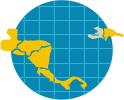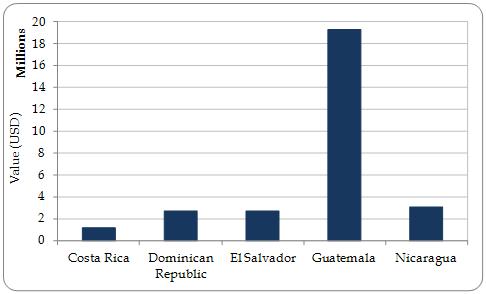The minimum monetary value to countries in the Region of direct exports of CITES-listed animal species is estimated in this chapter. To calculate the value of relevant exports from the Region, we use a preliminary methodology developed by UNEP-WCMC for the Analysis of EU Annual Reports using species-specific value data in US dollars (USD) that are included in the United States annual report to CITES (as transmitted by the United States Fish and Wildlife Service) and reflect the amounts reported by traders via USFWS 3-177 forms[1] (see Valuation methodology overview).
This process provides a minimum estimated value, but it is important to note that it is an underestimate of the total value of CITES trade for several reasons: 1) it is the value as estimated by traders at only one point in the value chain (at the time of trade) and does not reflect the full value of the commodity; 2) valuation of plant exports (including timber) was not undertaken as no value dataset with adequate coverage was available at the time of analysis; and 3) wildlife commodities (re-)exported by the Region were not included in the analysis. Further details of the methodology, along with caveats to this approach, are provided here.
Overall value of exports of CITES-listed animal species from the Region 2003-2012
Value across the Region
The total monetary value of reported direct exports of CITES-listed animals from the Region over the ten year period 2003-2012 is estimated to be approximately USD113 million based on exporter-reported trade. When importer-reported trade volumes are assessed, the value of imports from the Region is estimated to be roughly 86% greater (~USD210 million), reflecting the discrepancies in reported trade volumes between the Region and its trading partners. Over the ten year period, the value of CITES trade from the Region appears to have decreased overall (Figure 6.1), averaging USD5.8 million per year over the period 2008-2012 compared to USD16.8 million per year over the period 2003-2007, based on exporter-reported trade volumes.
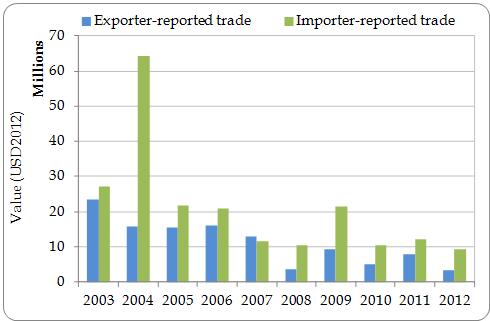
Figure 6.1. Value (USD 2012 equivalent) of animal commodities directly exported by the Region over time 2003-2012, based on exporter- and importer-reported trade volumes.
The trade in reptiles accounted for 61% of the value of animal exports according to exporter-reported trade data and 40% according to importer-reported data, reflecting the relatively high volume of exports of this group (Figures 6.2 and 6.3).
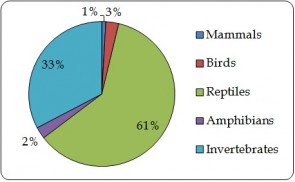
Figure 6.2. Proportion of value (2012 USD equivalent) of direct exports of animal products by taxonomic group based on trade
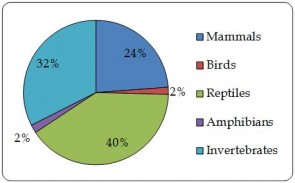
Figure 6.3. Proportion of value (2012 USD equivalent) of direct exports of animal products by taxonomic group based on trade volumes recorded by importers, 2003-2012.
The discrepancy between the proportions represented in Figures 6.2 and 6.3 is due to the large quantity of Cetacean[1] carvings – estimated to value ~USD26,000 each – that were recorded by importers in 2004, but not recorded by the exporter. If these carvings are excluded, then the proportionate values by group based on exporter- and importer-reported data are comparable, with reptiles (53%) and invertebrates (43%) dominating, as recorded by importers.
Value by country
Four countries together account for 95% of the total value of animal exports from the Region: Panama (26%), El Salvador (23%), Honduras (23%) and Nicaragua (23%; Figure 6.4). Table 6.1 details the value of animal exports from each country by year.
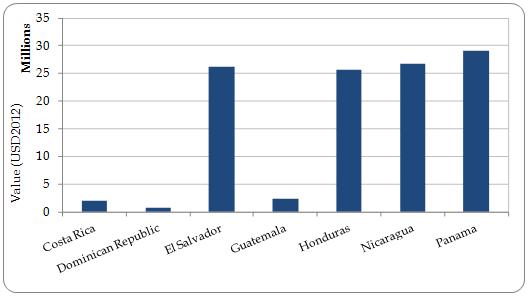
Figure 6.4. Estimated value (2012 USD equivalent) of direct exports of CITES-listed animal species from the Region by exporting country, 2003-2012.
Table 6.1. Total estimated value in millions of USD (2012 equivalent) of direct exports of CITES-listed animal species from the Region by exporting country and year, based on trade data reported by exporters (E) and importers (I), 2003-2012. Figures rounded to two decimal places, where applicable.
| Country | Rep. type* | 2003 | 2004 | 2005 | 2006 | 2007 | 2008 | 2009 | 2010 | 2011 | 2012 | Total |
|---|---|---|---|---|---|---|---|---|---|---|---|---|
| CR | E | 0.1 | 0.03 | 0.12 | 0.07 | 0.03 | 0.07 | 0.06 | 0.03 | 1.57 | - | 2.06 |
| I | 0.06 | 0.02 | 0.08 | 0.01 | 0.03 | 0.02 | 0.03 | 0.16 | 0.02 | 0.02 | 0.44 | |
| DO | E | - | 0.85 | - | <0.01[/r] | <0.01[/r] | <0.01[/r] | <0.01[/r] | <0.01[/r] | <0.01[/r] | <0.01[/r] | 0.86 |
| I | 7.44 | 49.99 | 0.11 | 0.18 | 0.05 | 1.25 | 6.05 | 0.3 | <0.01[/r] | 0.04 | 65.4 | |
| SV | E | 4.14 | 5.15 | 1.25 | 3.92 | 3.78 | - | 2.79 | 1.91 | 1.59 | 1.74 | 26.26 |
| I | 2.51 | 3.11 | 2.84 | 2.82 | 2.7 | 2.49 | 2.11 | 2.15 | 1.63 | 1.65 | 24 | |
| GT | E | 1.1 | 0.07 | 0.08 | 0.23 | 0.04 | 0.14 | 0.15 | 0.02 | 0.53 | - | 2.35 |
| I | 1.07 | 0.09 | 0.04 | 0.03 | 0.03 | 0.21 | 0.15 | 0.02 | 1.24 | 0.04 | 2.91 | |
| HN | E | 11.95 | 0.08 | 0.15 | 2.88 | 2.55 | 0.02 | 1.27 | 2.23 | 3.04 | 1.51 | 25.68 |
| I | 10.89 | 0.07 | 0.03 | 2.37 | 2.24 | 0.01 | 8.31 | 1.68 | 2.38 | 1.92 | 29.91 | |
| NI | E | 4.4 | 5.52 | 3.22 | 3.8 | 2.13 | 2.75 | 4.89 | - | - | - | 26.71 |
| I | 3.74 | 5.23 | 2.58 | 3.74 | 3.01 | 1.97 | 3.13 | 4.16 | 4.2 | 5.43 | 37.18 | |
| PA | E | 1.87 | 4.17 | 10.66 | 5.2 | 4.44 | 0.62 | - | 0.96 | 1.23 | - | 29.15 |
| I | 1.53 | 5.77 | 16.18 | 11.74 | 3.44 | 4.5 | 1.75 | 1.95 | 2.59 | 0.33 | 49.8 | |
| Subtotals | E | 23.55 | 15.86 | 15.48 | 16.1 | 12.96 | 3.6 | 9.17 | 5.14 | 7.96 | 3.24 | 113.06 |
| I | 27.23 | 64.27 | 21.87 | 20.9 | 11.49 | 10.45 | 21.53 | 10.42 | 12.05 | 9.43 | 209.64 |
When the findings from this analysis were compared with a previous study on the value of CITES-listed species in the region (CCAD 2010[2]), the total figures shown in Table 6.1 (USD113 million according to exporters and USD209 million according to importers) are less than that derived by extrapolating the value of CITES trade from five countries in the region reported in 2007 to a ten year period (~289 million); however, the likely cause for the discrepancy is the inclusion of plant value estimates within the latter figure (See Box 6.1. for details on the findings of the CCAD 2010 study).
Box 6.1. Findings in relation to valuation of CITES trade in the Report on the Economic Valuation of the Process of Implementation of the CITES Convention (CCAD, 2010[1])
- Costa Rica: Cycas revoluta (USD933,000)
- Dominican Republic: cacti, cycads, euphorbias, mahogany and orchids (the import of mahogany from countries such as Fiji, Guatemala and Nicaragua, primarily for the national market, is of higher value at c. USD10 million)
- El Salvador: Iguana iguana (USD2.2 million; 563,000 specimens)
- Guatemala: Swietenia macrophylla (USD8.6 million; 7750m3)
- Nicaragua: Strombus gigas (USD1.5 million).
The report recommends that further studies should be conducted to more accurately determine the value of species and their contribution to national and regional economies, and to assess which species could generate added value.
[1]Comisión Centroamericana de Ambiente y Desarrollo (CCAD) (2010). Informe de Valoracion Economica del Proceso de Implementación de la Convencion CITES en Guatemala, El Salvador, Nicaragua, Costa Rica y República Dominicana. CCAD, Centroamérica.
[1]Reported at the order level (Cetacea spp.).
[2]Comisión Centroamericana de Ambiente y Desarrollo (CCAD) (2010). Informe de Valoracion Economica del Proceso de Implementación de la Convencion CITES en Guatemala, El Salvador, Nicaragua, Costa Rica y República Dominicana. CCAD, Centroamérica.
Key commodities exported by the Region by value
The value of key commodities exported by the Region over the period 2003-2012 is summarised in Figure 6.6. Live animals and meat (kg), the two animal commodities traded in the highest quantities, were also the top two commodities by value, representing 33% and 30% of the total estimated value, respectively.
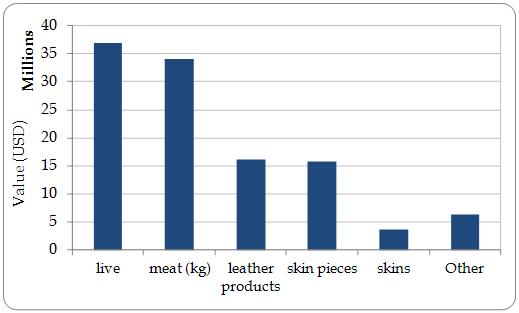
Figure 6.6. Value (2012 USD equivalent) of trade in the top five animal commodities (by value) directly exported by the Region 2003-2012, with an indication of the combined value of the remaining term/unit combinations (“Other”).
Live animals
The total estimated value of the 4.2 million live animals exported by the Region over the period 2003-2012 was approximately USD37 million. Reptiles accounted for the majority of live animal trade both by volume (~98%) and by value (~84%) (Table 6.2). Amphibians and birds had relatively high values (8% and 7%, respectively) compared with the proportion of the trade they represent by trade volume.
Table 6.2. Total estimated value (USD 2012 equivalent) and corresponding quantity of direct exports of live animals from the Region by taxonomic group based on exporter-reported trade, 2003-2012. Number rounded to the nearest 5. Percentages of total provided in brackets.
| Group | Exporter-reported Quantity | Value (USD) |
|---|---|---|
| Mammals | 330 (<1%)[/r] | 521,615 (1%) |
| Birds | 5705 (<1%)[/r] | 2,662,055 (7%) |
| Reptiles | 4,132,050 (98%) | 30,889,585 (84%) |
| Amphibians | 91,215 (2%) | 2,897,780 (8%) |
| Invertebrates | 1275 (<1%)[/r] | 7200 (<1%)[/r] |
| Total | 4,230,575 | 36,978,240 |
Iguanidae was the predominant reptile family in trade, accounting for >97% of the quantity of live reptiles traded and ~75% of the value attributed to live reptiles, and dominated by trade in one species: Iguana iguana (>99%). The estimated value for live Iguanidae was ~USD23 million. Estimated values for Boidae (~USD4 million), Testudinidae (USD2.3 million) and Alligatoridae (~USD1 million) were also notable. All other families had estimated values in trade of less than USD250,000. The vast majority of the live reptile trade was in captive-produced specimens, representing 99.8% of the trade by volume and 99.5% of the value.
Trade in live amphibians was valued at USD2.9 million over the period 2003-2012, with the majority of the value (92%) attributed to the family Dendrobatidae. Of these, captive-bred specimens accounted for 87% of the economic value; 12.5% of the value can be attributed to trade recorded without a source specified.
The value of live birds exported by the Region over the ten-year period 2003-2012 was roughly USD2.6 million, with the family Psittacidae accounting for the majority of the value (USD2.3 million; 88%), followed by Ramphastidae (USD270,000; 10%). The main species in trade, ranked by value, were Amazona autumnalis, Amazona albifrons, Pionus senilis and Ramphastos sulfuratus. The majority of the value can be attributed to birds from ranched sources (83%), with only 8% of the value (~USD200,000) derived from wild-sourced birds. The majority of the trade in live, ranched birds was recorded in the years 2003 and 2004; since that time only one ranched bird was reported exported in 2005 and three in 2011.
The value of live mammal exports totalled USD521,615, with captive-bred animals representing the highest proportion (85%) of the value. The top two families by value were Cebidae (53% – all Callithrix pygmaea and Cebus capucinus) and Felidae (30% – primarily Panthera tigris and Panthera leo recorded with purpose ‘Q’ or without a purpose specified). Exports of live animals recorded in kilograms were valued at an estimated additional USD537,500.
Meat (kg)
Meat (kg) was the second most valuable animal commodity, worth roughly USD34 million and accounting for 30% of the total value of animal exports. Exports of Strombus gigas meat (kg) dominated the trade and accounted for >99% of the value of meat exports. Of this, wild-sourced trade accounted for 83% of the value (~USD28 million), trade without a source specified accounted for 15% of the value and the remainder was recorded as captive-bred. The values by source are proportionate to the quantities traded as only one valid price value was available from the US dataset – a median value of USD12.32 per kg on the basis of 969 records of wild-sourced trade in Strombidae meat (kg). Strombus gigas meat products recorded without a unit specified (but likely to be kilograms) were estimated to be worth an additional USD275,000.
The only other species exported for its meat was Iguana iguana, with meat trade in this species worth an estimated USD127,000 (all reportedly captive-bred).
Leather products
Leather products exported by the Region 2003-2012 were worth approximately USD16 million, accounting for 14% of the total value of animal exports. Alligatoridae was the predominant family in trade by value, accounting for 99.9% of exports of leather products by value. Of the Alligatoridae trade, 99.99% was in the subspecies Caiman crocodilus fuscus, with the remainder reported as Caiman yacare and Caiman spp. Wild-sourced leather products accounted for 60% (USD9.7 million) of the value of leather products, with the remainder captive-bred. The median price values used to estimate the overall value were USD241.11 for wild-sourced leather products (based on over 58,000 records in the US dataset) and USD129.55 for captive-bred leather products (based on over 16,700 records).
Skin pieces
Skin pieces had an estimated value of USD15.8 million and comprised 14% of the total estimated value of animal exports from the Region 2003-2012. All of the skin pieces were of captive-bred Caiman crocodilus (including C. c. fuscus). The median value for captive-bred Alligatoridae was USD43.53 per skin piece.
Exports of skin pieces recorded in kilograms were valued at an estimated additional USD100,000.
Skins
With an estimated value of USD3.6 million, skins represented 3% of the value of animal exports from the Region. Similarly to skin pieces and leather products, reptiles again accounted for the vast majority (>99%) of the value associated with this commodity. Alligatoridae accounted for 84% of the trade by value, again predominantly Caiman crocodilus fuscus. The economic values of skins of the families Crocodylidae and Iguanidae were also notable, worth USD508,000 and USD60,500 respectively.
Captive-bred skins accounted for the majority of the value of the skin trade (87%), with skins reported without a source specified representing 11% of skins by value (Crocodylus acutus and Alligatoridae spp.).
Other parts and derivatives
Four additional animal parts and derivatives exported by the Region are also worth noting with respect to economic value: derivatives, shells (reported by number and in kg), feathers and horns. Each had estimated values in excess of USD400,000. The value of derivatives, estimated at USD2 million, can be attributed almost exclusively to two species, in both cases wild-sourced: Chelonia mydas (78%; ~USD1.55 million) and Strombus gigas (22%; ~USD440,000).
Exports of shells (recorded by number and by weight), totalled an estimated USD1.6 million, all involving trade in wild-sourced Strombus gigas.
The estimated value of exports of feathers was USD488,000, predominantly of the family Psittacidae (93%). The majority of Psittacidae were traded as captive-bred (67% by value), with the remainder of the value from wild-sourced trade. Wild-sourced feathers of the families Trochilidae and Accipitridae were also traded, although at much lower levels (accounting for 6% and <1% of the value, respectively).
Trade in horns was dominated by exports of pre-Convention Ceratotherium simum, representing >99% of the value of horns (USD430,000).
Box 6.2. Focus on Strombus gigas (Queen Conch)
The methodology used in this report estimated a value of USD12.3 per kg of Strombus gigas meat. This is comparable to the value reported by Barzev (2009)[1] of USD13.2 per kg of pure white S. gigas meat exported by Nicaragua. Reported prices in domestic markets range from USD3/kg (Theile, 2001[2]) to USD11/kg for locally harvested meat and USD20/kg for imported meat in the French Antilles (AC19 Doc. 8.3 (Rev. 1)).
Barzev (2009) analysed the value chain for S. gigas meat from harvest to the point of export in Nicaragua. The average price and corresponding profit margin earned at each stage in the chain, from diver through intermediary to processing plant, are shown in Figures 6.7 and 6.8. Both prices and profit margins increase through the chain.

Figure 6.7. Average price (USD) per kg of Strombus gigas meat earned at the three main stages of the harvest chain in Nicaragua. (Source: Barzev, 2009.)
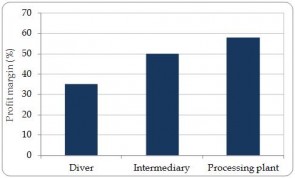
Figure 6.8. Profit margin (%) for Strombus gigas meat earned at the three main stages of the harvest chain in Nicaragua. (Source: Barzev, 2009.)
The same study also examined the value of S. gigas products other than meat, including shells, opercula and skins. The study concluded that the value of S. gigas meat exports from Nicaragua would increase over three-fold, from USD13.2/kg to USD44/kg, if all sub-products were sold (Barzev, 2009). This indicates that, based on the value of approximately USD34 million estimated in this report for S. gigas meat exports from the Region, the potential total value of S. gigas exports from the Region could be up to USD113 million. The value estimated in this report for non-meat products of S. gigas (shells and derivatives) amounted to only USD2 million, although this figure does not capture domestic trade.
[1]Barzev, R. (2009). Valoración económica CITES en Centroamérica: Caso de Nicaragua. Managua, Nicaragua.
[2]Theile, S. (2001). Queen Conch fisheries and their management in the Caribbean. Technical report to the CITES Secretariat. TRAFFIC Europe, Brussels, Belgium.
Conclusions
The monetary value of reported direct exports of CITES-listed animals over the ten year period 2003-2012 is estimated to be over USD113 million, based on exporter-reported trade figures. The figure rises to roughly USD209 million on the basis of importer-reported trade quantities. Live animals (primarily reptiles), meat (Stombus gigas) and reptile skins and skin products accounted for the majority of the estimated value (based on exporter-reported data). The inclusion of plant data in future analyses will aid with providing a closer estimate to the real value of CITES trade to the Region.
[1]Data included in the U.S. CITES annual reports were used as these data provide a standardised dataset that involves similar assumptions across all taxa. Attempts were made to remove anomalies; see the Valuation methodology overview for caveats to this approach.
